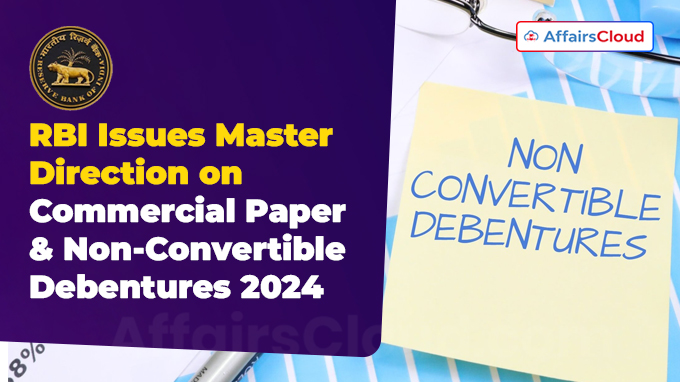 On January 3, 2024, the Reserve Bank of India (RBI) issued Master Direction – RBI (Commercial Paper and Non-Convertible Debentures of original or initial maturity upto one year) Directions, 2024 which will come into effect from April 1, 2024.
On January 3, 2024, the Reserve Bank of India (RBI) issued Master Direction – RBI (Commercial Paper and Non-Convertible Debentures of original or initial maturity upto one year) Directions, 2024 which will come into effect from April 1, 2024.
- These Directions have been issued in exercise of the powers conferred under section 45J, 45K, 45L and 45W of RBI Act, 1934 read with section 45U of the Act and of all the powers enabling it in this behalf.
Tenor:
i.Non-Convertible Debenture (NCD) means a secured money market instrument with a tenor between 90 days and one year.
ii.Commercial Paper (CP) means an unsecured money market instrument issued in the form of a promissory note with maturity between a minimum of 7 days and a maximum of up to one year from the date of issue.
Guidelines:
i.CPs and NCDs must be issued and held in dematerialized form with a Securities and Exchange Board of India (SEBI) registered depository.
ii.The minimum denomination for CPs and NCDs is Rs 5 lakh, with multiples of Rs 5 lakh thereafter.
iii.CPs have a tenor between seven days and one year, while NCDs have a tenor between ninety days and one year.
iv.Issuance of CPs/NCDs with options (call/put) is not allowed, and underwriting or co-acceptance is prohibited.
v.Primary issuances of CPs and NCDs, involving both fund payment to the issuer and issuance to investors, must be settled within T+4 working days from the deal date.
vi.The date on which the trade details, including price/rate are agreed by the issuer and the investor(s).
vii.Individual subscriptions, including Hindu Undivided Families (HUFs), in any primary CP or NCD issuance cannot exceed 25% of the total amount issued.
Discount/Coupon Rate
i.CPs are issued at a discount to the face value.
ii.NCDs can be issued at a discount to the face value or with a fixed or floating rate coupon.
iii.The coupon on floating rate NCDs is linked to a benchmark approved by Financial Benchmark Administrator or approved by the Fixed Income Money Market and Derivatives Association of India (FIMMDA) ensuring transparency and objectivity, or it can be linked to policy rates published by the Reserve Bank.
Rating Requirement
The minimum credit rating, assigned by a Credit Rating Agency (CRA), for the issuance of CPs and NCDs is ‘A3’.
Credit Enhancement:
i.Banks and AIFIs can provide credit enhancement like stand-by assistance or back-stop facility for CP/NCD issues based on commercial judgment and within RBI’s prudential guidelines.
ii.Non-bank entities, including corporates, can offer unconditional and irrevocable guarantees for credit enhancement of CPs and NCDs issued by a group entity.
End-use
i.CPs and NCDs funds are primarily for current assets and operating expenses.
- If funds are utilized for purposes other than the specified, the exact end-use must be disclosed in the offer document.
ii.A certificate from the CEO (Chief Executive Officer)/CFO (Chief Financial Officer) confirming proper use and adherence to regulatory provisions and conditions must be submitted to the Issuing and Paying Agent (IPA) within 3 months of CP/NCD issue or maturity, whichever is earlier.
Key Points:
i.CPs and NCDs are tradable on OTC markets, including ETPs, or approved stock exchanges by the Reserve Bank.
ii.Settlement cycle for OTC trades is T+0 or T+1.
iii.IPA reports primary market issuances on F-TRAC Trade Repository Platform of Clearing Corporation of India Ltd (F-TRAC platform) by 5:30 PM on the day of issuance.
iv.Secondary market transactions in CPs and NCDs are reported within 15 minutes on F-TRAC.
v.Buyback details reported by IPA on F-TRAC platform by 5:30 PM on buyback date.
vi.Instances of default and repayment reported by IPA on F-TRAC by 5:30 PM on the day of default or repayment.
vii.Depositories report CPs and NCDs details to RBI fortnightly or as required.
viii.Debenture Trustee reports NCD outstanding amount and default particulars quarterly within 15 days from the quarter-end.
Eligible Issuers:
i.CPs and NCDs may be issued by the following entities:
- Companies; Non-Banking Financial Companies (NBFCs), including Housing Finance Companies (HFCs); Infrastructure Investment Trusts (InvITs) and Real Estate Investment Trusts (REITs) ; All India Financial Institutions (AIFIs)
- Any other body corporate with a minimum net-worth of Rs 100 crore, provided that the body corporate is statutorily permitted to incur debt or issue debt instruments in India
- Any other entity specifically permitted by the Reserve Bank.
ii.Co-operative societies and limited liability partnerships with a minimum net-worth of Rs 100 crore, may issue CPs under these Directions, subject to the condition that all fund-based facilities availed, if any, by the issuer from banks/ AIFIs / NBFCs are classified as Standard at the time of issue.
Eligible Investors:
All residents can invest in CPs and NCDs.
Non-residents can invest based on Foreign Exchange Management Act (FEMA), 1999 regulations.
Recent Related News:
i.Reserve Bank Innovation Hub (RBIH) is developing a digital Public Tech Platform to facilitate easy lending by providing necessary digital data to lenders. It will have an open architecture, allowing financial players to connect seamlessly using open Application Programming Interfaces (APIs) in a ‘plug and play’ model.
ii.RBI plans to introduce ‘conversational payments’ on UPI, allowing users to securely initiate and finalize transactions through AI-powered conversations. This feature will be accessible on both smartphone and feature phone UPI platforms, aiding the expansion of digital adoption across India. Initially in Hindi and English, it will later be available in additional Indian languages.
About Reserve Bank of India (RBI):
Governor– Shaktikanta Das
Deputy Governors–Michael Debabrata Patra, M. Rajeshwar Rao, T. Rabi Sankar, and
Swaminathan Janakiraman
Establishment– 1st April 1935
Headquarters– Mumbai, Maharashtra




